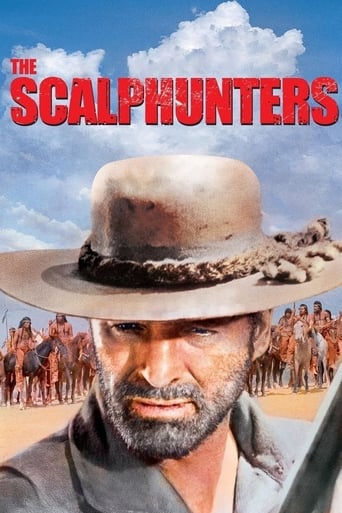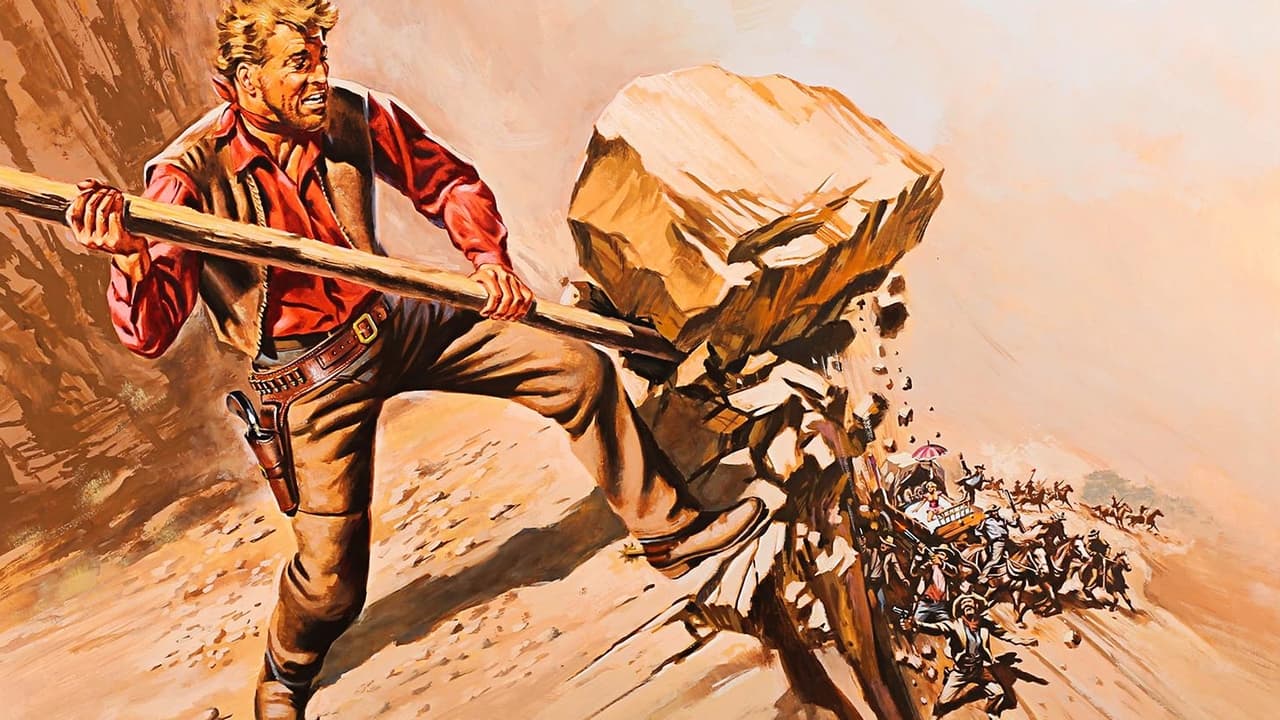gavin6942
Forced to trade his valuable furs for a well-educated escaped slave, a rugged trapper vows to recover the pelts from the Indians and later the renegades that killed them.Ossie Davis was nominated for a Golden Globe for Best Supporting Actor for his performance in the film. And, really, his appearance is the highlight of the film. As far as westerns go, it is rather disappointing. And the artwork makes it seem almost like an exploitation film, which it most certainly is not. The cast is good, but does not make the film as a whole all that great. Frankly, I am not sure why Shelley Winters was ever a star.Thanks to Kino Lorber, this film is available on DVD. I can't say it's the best thing they've released, but it probably isn't the worst.
flask
Sydney Pollack's "The Scalphunters" is a briskly-paced, revisionist Western with an entertaining script and equally entertaining performances by a strong cast. Given the title, some viewers may expect a serious and gritty drama about the depraved scalp hunters who plagued the American West. However, in actuality, this well-written light-hearted film is a clever blend of both comedic and dramatic elements.The story is complicated, yet easy to follow: Joe Bass (Burt Lancaster) is a grizzled, Bible-reciting fur trapper with a monomaniacal attachment to his beaver pelts. Held up by Indians, Bass is forced to exchange his pelts for the tethered Joseph Lee (Ossie Davis), an escaped slave who formerly served an educated family in Louisiana. Bass and a reluctant Lee pursue the Indians but, through a twist of fate, Bass' furs fall into the hands of scalp hunters led by Jim Howie (the always engaging Telly Savalas), a burly ruffian henpecked by his prostitute-girlfriend Kate (a fussy, cigar-chewing Shelley Winters).It is the latter performances which is the key to the film's success. Lancaster, Davis, Savalas and Winters effortlessly spin out humorous performances. And the best scenes are the humorous ones, such as when Savalas yells at Winters' to stop singing those damn Mormon songs or when Savalas defiantly tells Lancaster that he will kill him then steps on a cactus while returning to the wagon.Yet for all its amusing tomfoolery, the film has a message: The axis of that message revolves around the dyadic relationship between trapper Joe Bass and the slave Joseph Lee; their hopes and their prejudices. Bass desires only to reacquire his pelts and Lee desires only to escape to Mexico. Both are reluctant to help the other. Each holds the other in contempt: Bass views Lee as a meek slave, and Lee views Bass as an uneducated hick. But, in the final scene, both characters are covered in mud; the color of their skin obscured. It is in this scene they find their equality, and one grasps the subtly of the film's psychology.
MartinHafer
This is a film I really wanted to like. After all, some of the actors were very skilled and the characters they played had some wonderful qualities. Additionally, this movie would have been a great comedy or drama--too bad the writers and director had no sense about which they were going to make! I think the recent success of comedy-Westerns such as CAT BALLOU and THE HALLELUJAH TRAIL impacted this film--but these other films were consistent in their style, while THE SCALPHUNTERS sure wasn't.Burt Lancaster plays one of the less sympathetic roles of his career. Early on, his huge load of furs is stolen, of sorts, by a group of Indians. What actually occurred is that they took the furs and gave him an escaped Black slave--which Burt did NOT want nor need. He treated Davis mostly like a piece of property, not a man. Ossie Davis was fun to watch as this well educated Black man, though this was certainly an anachronism--as in most of the South, a Black slave who could read and write would have been hung, as it was against the law to educate a Black person (lest they learn about the real world or the inequity of slavery). To make this situation less believable, Davis knew quite a bit of Latin and about the world--making him smarter than at least 95% of White Americans at this same time in history.Speaking of time in history, it's very hard to figure out when this film was to have occurred. You know it MUST be pre-Civil War since there is slavery and yet the guns are all repeating rifles and pistols--something you would have had a hard time finding even by the end of the Civil War. Some early cartridge guns had been developed by about 1860, but they were very rare and unreliable and would have almost never been seen in the West. Despite this, you don't see any single-shot guns--only repeating rifles and pistols using cartridges that are circa 1870 and later. Plus, none of these repeaters seem to need reloading! Despite all these logical errors and anachronisms, there is a lot to like in the film--and lots of wonderful scenes. Davis' anachronistic character is very likable and he has many great lines. Lancaster, while a thoughtless jerk is also a pretty exciting action hero at times in the film. The relationship between these two is interesting and complex. Plus I liked seeing the relationship between Telly Savalas and Shelley Winters--their dialog was pretty funny at times and how Winters ended the film was rather satisfying.Unfortunately, all the scenes, when placed together, are a mess and just don't fit together well. Much of this is because the movie moves uncomfortably from action film to comedy--and it's hard to laugh at a comedy about slavery or the massacre of Indians! The best example of this is the ending of the film. After suffering through tons of abuse and ambivalence by Lancaster, Davis has a wonderful scene where he is about to leave Lancaster in the desert and ride off to Mexico for a happy ending--a well-deserved and very rewarding ending I might add. However, oddly, the film did NOT end here but when one for about another ten minutes--and then tried to give a comedic style ending that just didn't fit the film at all. Ending it with Lancaster tied up and Davis wandering off would have been perfect--dragging it on and having a macho mud fight for a laugh was just awful and totally destroyed the impact of the film as social commentary.
tedg
If you happen to be alive and watching films in the late 60s, you'd be immersed in a period richer than anything we have seen since, I think. People just seemed more receptive to fundamental reinvention where today its assurance we need.There are lots of obvious examples of this. Here's a much less obvious one, and it may be hard to see why.Superficially it is a slight project, a slim entertainment in a common form: a genre film that references the established notions of western justice that has in the standard interstices a story of racial justice earned. (You have to imagine that in those days it was commonly accepted that the black "man" had by dint of intense perseverance finally achieved a place at the table. Also, you have to place yourself in a place where the western was still taken seriously and without irony as the zone where American values were handled, reaffirmed.)Its not obvious today, because notions of race have since shifted. But this was a fairly radical film in its time: more so say than "Guess Who's Coming to Dinner," or "Lilies of the Field." The idea of weaving these two notions of justice together was pretty radical, and extremely ennobling. It was a special event then. Today, its old candy.And that's the power of this, knowing what it was and seeing how tepid the "message" is. Today, we're as likely to see the whore with the golden heart as mattering.Ted's Evaluation -- 2 of 3: Has some interesting elements.



 AD
AD





